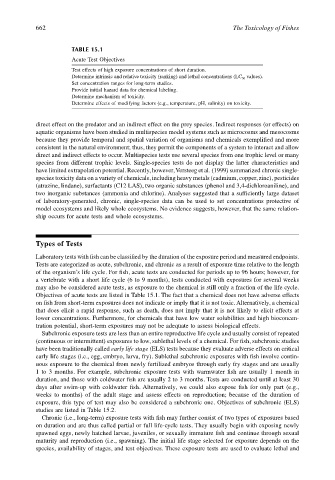Page 682 - The Toxicology of Fishes
P. 682
662 The Toxicology of Fishes
TABLE 15.1
Acute Test Objectives
Test effects of high exposure concentrations of short duration.
Determine intrinsic and relative toxicity (ranking) and lethal concentrations (LC 50 values).
Set concentration ranges for long-term studies.
Provide initial hazard data for chemical labeling.
Determine mechanism of toxicity.
Determine effects of modifying factors (e.g., temperature, pH, salinity) on toxicity.
direct effect on the predator and an indirect effect on the prey species. Indirect responses (or effects) on
aquatic organisms have been studied in multispecies model systems such as microcosms and mesocosms
because they provide temporal and spatial variation of organisms and chemicals exemplified and more
consistent in the natural environment; thus, they permit the components of a system to interact and allow
direct and indirect effects to occur. Multispecies tests use several species from one trophic level or many
species from different trophic levels. Single-species tests do not display the latter characteristics and
have limited extrapolation potential. Recently, however, Versteeg et al. (1999) summarized chronic single-
species toxicity data on a variety of chemicals, including heavy metals (cadmium, copper, zinc), pesticides
(atrazine, lindane), surfactants (C12 LAS), two organic substances (phenol and 3,4-dichloroaniline), and
two inorganic substances (ammonia and chlorine). Analyses suggested that a sufficiently large dataset
of laboratory-generated, chronic, single-species data can be used to set concentrations protective of
model ecosystems and likely whole ecosystems. No evidence suggests, however, that the same relation-
ship occurs for acute tests and whole ecosystems.
Types of Tests
Laboratory tests with fish can be classified by the duration of the exposure period and measured endpoints.
Tests are categorized as acute, subchronic, and chronic as a result of exposure time relative to the length
of the organism’s life cycle. For fish, acute tests are conducted for periods up to 96 hours; however, for
a vertebrate with a short life cycle (6 to 9 months), tests conducted with exposures for several weeks
may also be considered acute tests, as exposure to the chemical is still only a fraction of the life cycle.
Objectives of acute tests are listed in Table 15.1. The fact that a chemical does not have adverse effects
on fish from short-term exposures does not indicate or imply that it is not toxic. Alternatively, a chemical
that does elicit a rapid response, such as death, does not imply that it is not likely to elicit effects at
lower concentrations. Furthermore, for chemicals that have low water solubilities and high bioconcen-
tration potential, short-term exposures may not be adequate to assess biological effects.
Subchronic exposure tests are less than an entire reproductive life cycle and usually consist of repeated
(continuous or intermittent) exposures to low, sublethal levels of a chemical. For fish, subchronic studies
have been traditionally called early life stage (ELS) tests because they evaluate adverse effects on critical
early life stages (i.e., egg, embryo, larva, fry). Sublethal subchronic exposures with fish involve contin-
uous exposure to the chemical from newly fertilized embryos through early fry stages and are usually
1 to 3 months. For example, subchronic exposure tests with warmwater fish are usually 1 month in
duration, and those with coldwater fish are usually 2 to 3 months. Tests are conducted until at least 30
days after swim-up with coldwater fish. Alternatively, we could also expose fish for only part (e.g.,
weeks to months) of the adult stage and assess effects on reproduction; because of the duration of
exposure, this type of test may also be considered a subchronic one. Objectives of subchronic (ELS)
studies are listed in Table 15.2.
Chronic (i.e., long-term) exposure tests with fish may further consist of two types of exposures based
on duration and are thus called partial or full life-cycle tests. They usually begin with exposing newly
spawned eggs, newly hatched larvae, juveniles, or sexually immature fish and continue through sexual
maturity and reproduction (i.e., spawning). The initial life stage selected for exposure depends on the
species, availability of stages, and test objectives. These exposure tests are used to evaluate lethal and

